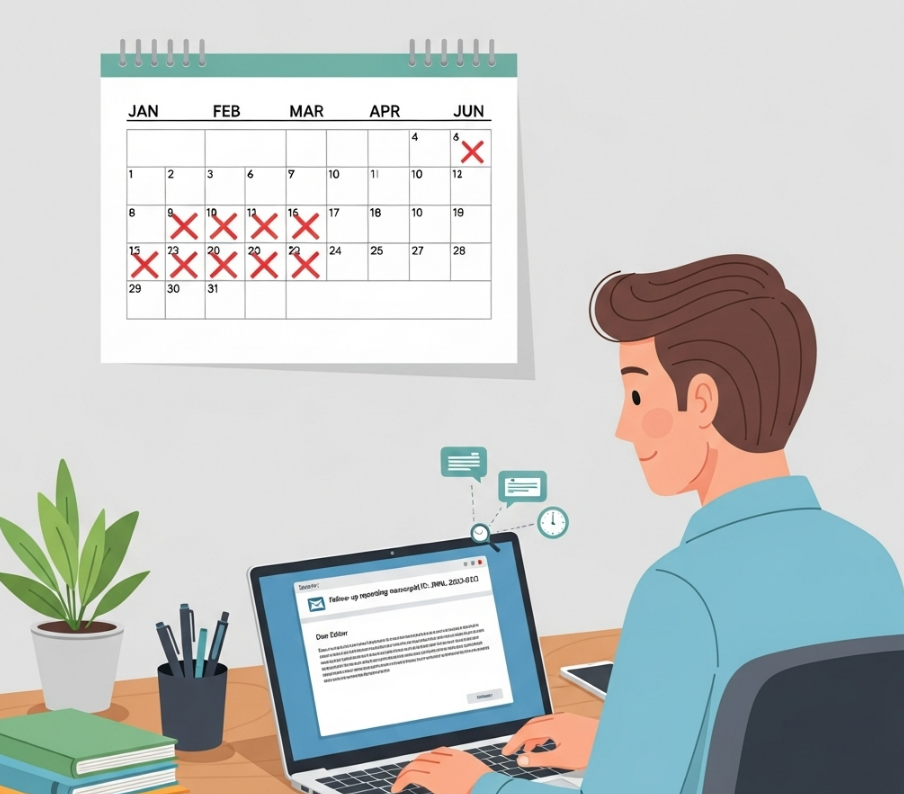

131 views||Release time: Sep 24, 2025
You’ve submitted your manuscript, the submission system says "Under Review," and then... silence. Weeks turn into months, and the anxiety builds. While the peer review process is notoriously long, there comes a point when you need to know what's happening.
Sending an email to the editor to inquire about your paper's status—often called a "follow-up" or "inquiry" email—is a standard and acceptable practice. However, how you write this email is crucial. A polite, professional, and patient inquiry can get you the information you need, while a demanding or impatient email can start your relationship with the editor on the wrong foot.

This guide will walk you through when to write, what to include, and what to avoid, complete with professional templates you can adapt.
Before you even open your email client, do these three things:
1. Check the Journal's Stated Review Time Most reputable journals provide an average time from submission to first decision on their "About" or "For Authors" page. This can range from 4 weeks to 6 months or more. If the journal states an average of 4 months, do not email them after 3 months.
2. Know When to Send the Email (Timing is Everything) The golden rule is to wait for the journal’s stated average review time to pass, plus a grace period of 2-4 weeks. Editors and reviewers are incredibly busy, and delays are common. Sending an email too early is the most common mistake and signals impatience.
(Current Date: September 24, 2025. If you submitted in April 2025 to a journal with a 4-month review time, now would be a perfectly reasonable time to inquire.)
3. Check the Submission Portal One Last Time Log in to the journal's online submission system. The status may have been updated to something like "Awaiting Reviewer Scores" or "Decision in Process," which tells you that progress is being made and you should wait a little longer.
Your email should be concise, respectful, and easy for the editor to process.
Subject Line: Be clear, specific, and include your manuscript ID. This is the most important element.
Example: Inquiry Regarding Manuscript ID #JOURNAL-2025-0123
Salutation: Use a formal and respectful greeting.
Example: Dear Dr. [Editor's Last Name],
The Opening: State your purpose directly but politely. Start by identifying your manuscript.
Example: I am writing to politely inquire about the current status of my manuscript, "[Your Manuscript Title]" (ID #JOURNAL-2025-0123), which was submitted to [Journal Name] on [Date of Submission].
The Body: Provide context and show understanding. Acknowledge that you respect their time.
Example: Our submission portal indicates that the manuscript has been under review since [Date], and as we have not received an update, I would be grateful for any information you could provide on its progress. I understand that you and the reviewers are very busy, and I appreciate the time and effort you are dedicating to the review process.
The Closing: End with a gentle call to action and a professional sign-off.
Example: Any update you could provide would be greatly appreciated. Thank you for your time and consideration.
Your Signature: Include your full name, affiliation, and the manuscript ID and title again for easy reference.
Subject: Inquiry Regarding Manuscript ID #[Your ID]
Dear Dr. [Editor's Last Name],
I hope this email finds you well.
I am writing to inquire about the status of my manuscript, "[Your Manuscript Title]" (ID #[Your ID]), which I submitted to [Journal Name] on [Date of Submission].
The submission system indicates the paper has been under review for [Number] months, and I was hoping you might be able to provide a brief update on the progress of the review process.
I understand you have a very busy schedule, and I sincerely appreciate your time and effort.
Thank you for your consideration.
Sincerely,
[Your Name] [Your Affiliation and Title] [Manuscript ID and Title]
(Send this only after waiting at least 3-4 more weeks after the first email).
Subject: Second Inquiry Regarding Manuscript ID #[Your ID]
Dear Dr. [Editor's Last Name],
I hope you are having a productive week.
I am writing to follow up on my previous email regarding the status of my manuscript, "[Your Manuscript Title]" (ID #[Your ID]), submitted on [Date of Submission].
I understand that the editorial process is complex and time-consuming. I would be very grateful if you could let me know if there is any update or if there is any additional information I can provide.
Thank you again for your time and attention to this matter.
Best regards,
[Your Name] [Your Affiliation and Title] [Manuscript ID and Title]
DON'T sound demanding or frustrated. (e.g., "Why is my paper taking so long?")
DON'T email too frequently. (Once every 4-6 weeks after the initial period is the absolute maximum).
DON'T complain about the review process.
DON'T forget to include your manuscript ID number.
By approaching the situation with patience and professionalism, you can maintain a positive relationship with the journal while getting the information you need.